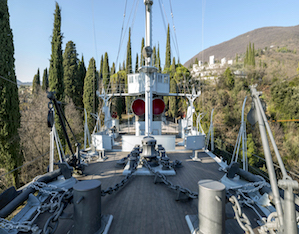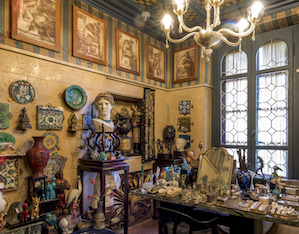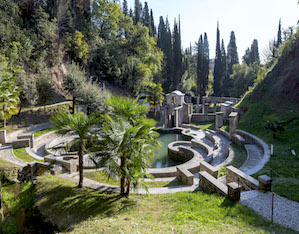The symbol of the “inimitable life” of a beloved and controversial Italian poet, this park is packed with allegories and self-celebrating symbology. Even more than the plants, the undisputed stars here are the statues, heirlooms, paths and elements of architecture with eccentric, evocative names.
In 1921, after Gabriele D’Annunzio’s failed raid to annex the city known today as Rijeka to the Kingdom of Italy (the “Impresa di Fiume”), the poet retired to Gardone Riviera, where he lived until his death in 1938. After buying the villa from German critic Henry Thode, D’Annunzio transformed it into a memorial to his own exploits and ideals. The poet’s former residence is surrounded by the Prioria’s highly-evocative, nine-hectare park. In an extraordinarily panoramic position, on a slope that runs down to Lake Garda through the Valletta dell’Acqua Pazza valley, the complex features the San Marco Tower and a dock of the same name. Olive trees, laurels, holm oaks, cypresses, oleanders and other local species surround a series of themed environments which D’Annunzio conceived himself, working closely with architect Giancarlo Maroni. A veritable outdoor museum, the gardens at the Vittoriale degli Italiani culminate in the Mausoleum where the poet is buried. Further downstream is an Open-Air Theatre (still used in summer), an Exedrawith a small temple, Piazzetta Dalmata (the poet’s residence, the Prioria, is accessed from here), the D’ Annunziano Museum, the Nave Puglia, Fontanone del Delfino, and the MAS 96 boatshed. In an exceptional symbiosis of botanical heritage, the symbolic heart of the estate, the Giardini della Prioria, are embellished with rich decor and references to classical gardens, the space filled with battlements, an orchard, rose garden, lemon house and the Arengocommunal assembly, where 27 columns surmounted by artillery shells celebrate victories during the Great War; here, D’Annunzio used to meet Fiume raid veterans and hold commemorative ceremonies on summer evenings.
Highlights

The Puglia
Gifted to the poet by the Navy, the bow, mast and decks of the “Nave Puglia” were reassembled piece by piece in the Vittoriale gardens, where they were mounted onto a concrete and stone reconstruction of the stern. The ship’s masts among the treetops are truly spectacular, as are the superb views from here out over the adjoining, recently-restored Valletta dell’Acqua Pazza, which ends at the Danze waterside theatre.

La Prioria
D’Annunzio’s taste for the arts in his home is evident in the more than 10,000 original objects and 33,000 books it contains. Enigmatic phrases and mottos on lintels, windows and mantelpieces provide an endless series of references and symbolic evocations.

The MAS 96 and the “Beffa di Buccari”
As a memento of the First World War and D’Annunzio’s heroism, the Vittoriale degli Italiani houses the motorboat on which the poet penetrated behind enemy lines on the night of 10 February 1918 to fire six torpedoes into the port of Buccari (Bakar), in Croatia.
 Il Vittoriale degli Italiani
Contacts
Il Vittoriale degli Italiani
Contacts
Contacts
Telephone:+39 0365 296511
Address
Via al Vittoriale, 12
25083, Gardone Riviera (BS)
 Il Vittoriale degli Italiani
Opening times and prices
Il Vittoriale degli Italiani
Opening times and prices
Opening hours
Vittoriale Park
- Summer opening hours (from 14 October to 11 March) 9.00 am – 4.00 pm (park closing at 5.00 pm)
- Winter opening hours (from 12 March to 12 October) 9.00 am – 7.00 pm (park closing at 8.00 pm)
Museo D’Annunzio Segreto, Museo D’Annunzio Eroe, Museo L’automobile è femmina
- Summer opening hours 9.00 am – 7.30 pm
- Winter opening hours 9:00 am – 4:45 pm (Saturday and Sunday until 5:15 pm)
Guided tour of the House (Priory)
- Summer opening hours 9:30 am – 7:00 pm (groups every 10-15 minutes)
- Winter opening hours 9:00 am – 4:00 pm (groups every 10-15 minutes)
The ticket office closes one hour before the Vittoriale. The House of Gabriele D’Annunzio (Priory) will be closed during the winter period:
- every Monday and Tuesday in November, December and January
- Mondays only in February and March except on public holidays
More info
- The visit to Gabriele D’Annunzio’s House is compulsorily guided and lasts about 35 minutes. 6 people enter at a time. For this reason tickets are limited in number. Reservations are therefore recommended for groups (minimum 25 people) and school groups.
- Individual visitors can not book but only buy the ticket via paypal or credit card directly online, until the day before the visit. The time of the visit of the House, also indicated on the entrance ticket of the Vittoriale, is mandatory and related to the turn of access to the Priory. You must arrive at the entrance at least half an hour before the chosen time. In case of delay, the visit will be moved to subsequent shifts but only upon availability and payment of an additional fee of 8 euros per ticket. Tickets sold are not refundable or replaceable.
- In order to enter the interiors, visitors are obliged to deposit their bags, fanny packs and cameras in the cloakroom.
Pricing
Complete Route
the visit includes the Parco Monumentale, Museo D’annunzio Segreto, Museo D’annunzio Eroe, Museo L’automobile è femmina, guided tour Casa (Prioria)
- Full price € 16,00
- Reduced € 13,00
- Groups € 13,00
- Reduced Admission: Young people from 7 to 18 years old and over 65; Groups (minimum 25 people); Schools; Families (composed of 2 paying adults and at least one paying child); Disabled accompanying persons; Holders of convention cards (e.g. TCI, FAI etc.); Military and State Police members
- Free admission: Children up to 6 years of age; Teachers (1 for every 15 students); Disabled persons over 70%; Disabled accompanying persons for school groups
Park Route
the visit includes The Monumental Park, D’Annunzio Secret Museum, The Car is Female Museum
- Full price € 10,00
- Reduced € 8,00
- Groups € 8,00
- Reduced Admission: Young people from 7 to 18 years old and over 65; Groups (minimum 25 people); Schools; Families (composed of 2 paying adults and at least one paying child); Disabled accompanying persons; Holders of convention cards (e.g. TCI, FAI etc.); Military and State Police members
- Free admission: Children up to 6 years of age; Teachers (1 for every 15 students); Disabled persons over 70%; Disabled accompanying persons for school groups
 Il Vittoriale degli Italiani
How to get there
Il Vittoriale degli Italiani
How to get there
Address
Via al Vittoriale, 12
25083, Gardone Riviera (BS)
Latitude: 45.6234592
Longitude: 10.5617294
How to arrive by road
- You can reach Gardone Riviera by car, where the Vittoriale is located, coming from the north on the A22 Brennero motorway, take the Rovereto Sud exit, then drive to Riva del Garda and continue on the SS45bis to Gardone Riviera.
- Arriving from the south, you can take the A4 motorway, exit at Brescia Est, and then continue on the ring road towards Salò, then take the SS45bis along Lake Garda until you reach Gardone. The Vittoriale is well signposted.
How to arrive by train
Reaching the Vittoriale by train is not very convenient, as the nearest train station is Desenzano or Brescia. You can then get to Gardone, and consequently to the Vittoriale, by taking the bus line that runs along the entire Garda coast. Before visiting the Vittoriale it is better to book a visit and avoid periods when there are school trips or holidays.
 Il Vittoriale degli Italiani
Services/Accessibility
Il Vittoriale degli Italiani
Services/Accessibility
Services
Dogs are allowed in outdoor areas
It is possible to book guided tours for individuals and groups and to take part in the educational activities organised for children and schools. Information and reservations at +39 0365 296511 or by writing to [email protected]
 Il Vittoriale degli Italiani
Private events
Il Vittoriale degli Italiani
Private events
 Il Vittoriale degli Italiani
Itineraries
Il Vittoriale degli Italiani
Itineraries
You could find the garden in these itineraries
 Favorite saving result
Favorite saving result
 Warning!
Warning!
You've have to sign up or sign in to add this element to your favorites.
